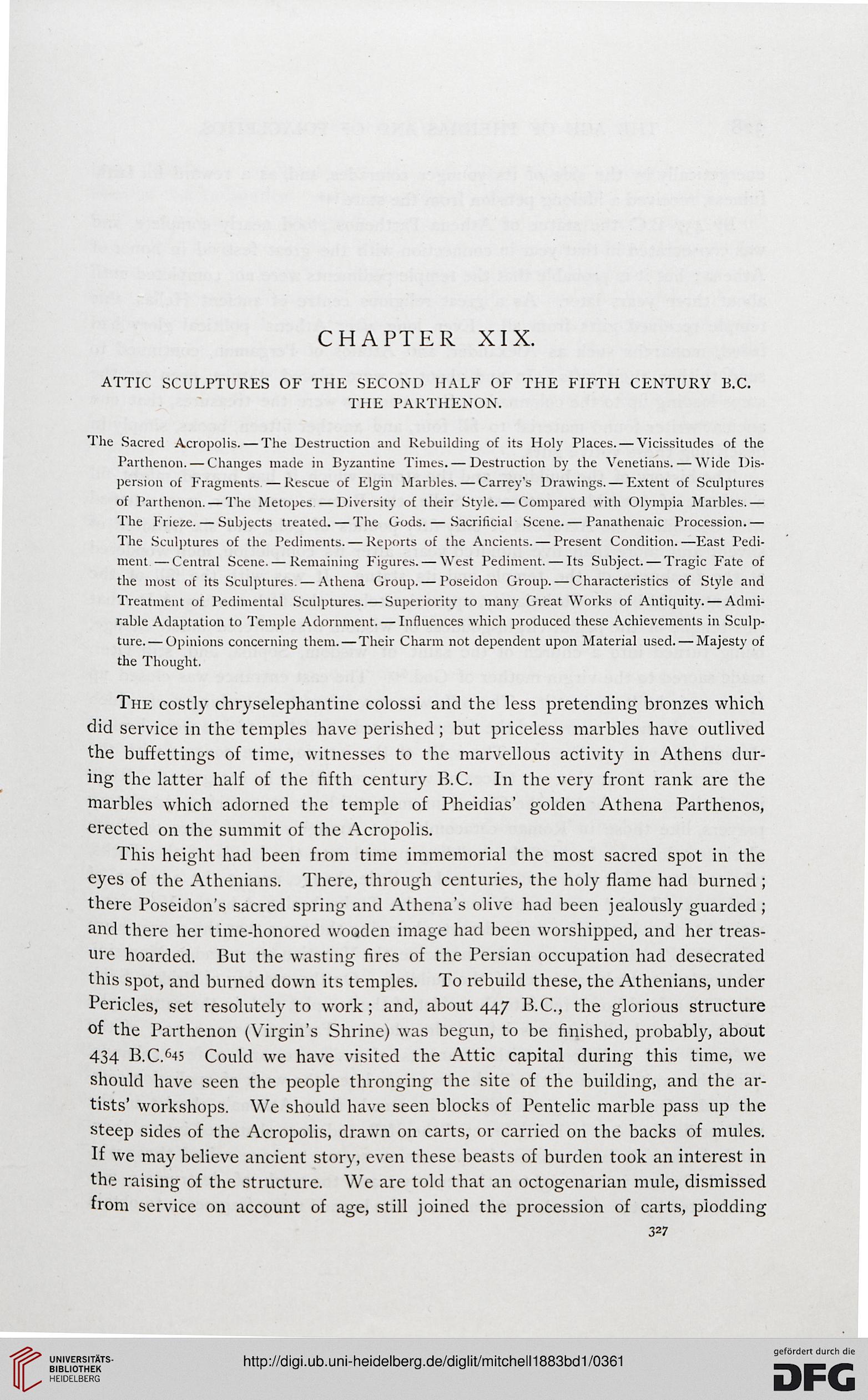CHAPTER XIX.
ATTIC SCULPTURES OF THE SECOND HALF OF THE FIFTH CENTURY B.C.
THE PARTHENON.
The Sacred Acropolis. — The Destruction and Rebuilding of its Holy Places. — Vicissitudes of the
Parthenon. — Changes made in Byzantine Times.— Destruction by the Venetians. — Wide Dis-
persion of Fragments —Rescue of Elgin Marbles. — Carrey's Drawings.— Extent of Sculptures
of Parthenon. — The Metopes —Diversity of their Style. — Compared with Olympia Marbles.—
The Frieze. — Subjects treated. — The Gods. — Sacrificial Scene. — Panathenaic Procession.—
The Sculptures of the Pediments. — Reports of the Ancients. — Present Condition.—East Pedi-
ment— Central Scene. — Remaining Figures. — West Pediment. — Its Subject. — Tragic Fate of
the most of its Sculptures. — Athena Group. — Poseidon Group.—-Characteristics of Style and
Treatment of Pedimental Sculptures. — Superiority to many Great Works of Antiquity. — Admi-
rable Adaptation to Temple Adornment. — Influences which produced these Achievements in Sculp-
ture.— Opinions concerning them. — Their Charm not dependent upon Material used. — Majesty of
the Thought.
The costly chryselephantine colossi and the less pretending bronzes which
did service in the temples have perished; but priceless marbles have outlived
the buffettings of time, witnesses to the marvellous activity in Athens dur-
ing the latter half of the fifth century B.C. In the very front rank are the
marbles which adorned the temple of Pheidias' golden Athena Parthenos,
erected on the summit of the Acropolis.
This height had been from time immemorial the most sacred spot in the
eyes of the Athenians. There, through centuries, the holy flame had burned ;
there Poseidon's sacred spring and Athena's olive had been jealously guarded ;
and there her time-honored wooden image had been worshipped, and her treas-
ure hoarded. But the wasting fires of the Persian occupation had desecrated
this spot, and burned down its temples. To rebuild these, the Athenians, under
Pericles, set resolutely to work; and, about 447 B.C., the glorious structure
of the Parthenon (Virgin's Shrine) was begun, to be finished, probably, about
434 B.C.6-t5 Could we have visited the Attic capital during this time, we
should have seen the people thronging the site of the building, and the ar-
tists' workshops. We should have seen blocks of Pentelic marble pass up the
steep sides of the Acropolis, drawn on carts, or carried on the backs of mules.
If we may believe ancient story, even these beasts of burden took an interest in
the raising of the structure. We are told that an octogenarian mule, dismissed
from service on account of age, still joined the procession of carts, plodding
32?
ATTIC SCULPTURES OF THE SECOND HALF OF THE FIFTH CENTURY B.C.
THE PARTHENON.
The Sacred Acropolis. — The Destruction and Rebuilding of its Holy Places. — Vicissitudes of the
Parthenon. — Changes made in Byzantine Times.— Destruction by the Venetians. — Wide Dis-
persion of Fragments —Rescue of Elgin Marbles. — Carrey's Drawings.— Extent of Sculptures
of Parthenon. — The Metopes —Diversity of their Style. — Compared with Olympia Marbles.—
The Frieze. — Subjects treated. — The Gods. — Sacrificial Scene. — Panathenaic Procession.—
The Sculptures of the Pediments. — Reports of the Ancients. — Present Condition.—East Pedi-
ment— Central Scene. — Remaining Figures. — West Pediment. — Its Subject. — Tragic Fate of
the most of its Sculptures. — Athena Group. — Poseidon Group.—-Characteristics of Style and
Treatment of Pedimental Sculptures. — Superiority to many Great Works of Antiquity. — Admi-
rable Adaptation to Temple Adornment. — Influences which produced these Achievements in Sculp-
ture.— Opinions concerning them. — Their Charm not dependent upon Material used. — Majesty of
the Thought.
The costly chryselephantine colossi and the less pretending bronzes which
did service in the temples have perished; but priceless marbles have outlived
the buffettings of time, witnesses to the marvellous activity in Athens dur-
ing the latter half of the fifth century B.C. In the very front rank are the
marbles which adorned the temple of Pheidias' golden Athena Parthenos,
erected on the summit of the Acropolis.
This height had been from time immemorial the most sacred spot in the
eyes of the Athenians. There, through centuries, the holy flame had burned ;
there Poseidon's sacred spring and Athena's olive had been jealously guarded ;
and there her time-honored wooden image had been worshipped, and her treas-
ure hoarded. But the wasting fires of the Persian occupation had desecrated
this spot, and burned down its temples. To rebuild these, the Athenians, under
Pericles, set resolutely to work; and, about 447 B.C., the glorious structure
of the Parthenon (Virgin's Shrine) was begun, to be finished, probably, about
434 B.C.6-t5 Could we have visited the Attic capital during this time, we
should have seen the people thronging the site of the building, and the ar-
tists' workshops. We should have seen blocks of Pentelic marble pass up the
steep sides of the Acropolis, drawn on carts, or carried on the backs of mules.
If we may believe ancient story, even these beasts of burden took an interest in
the raising of the structure. We are told that an octogenarian mule, dismissed
from service on account of age, still joined the procession of carts, plodding
32?




